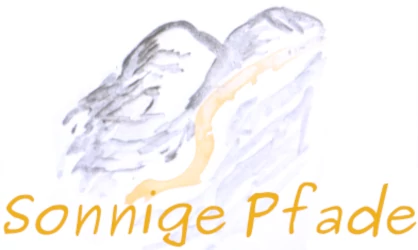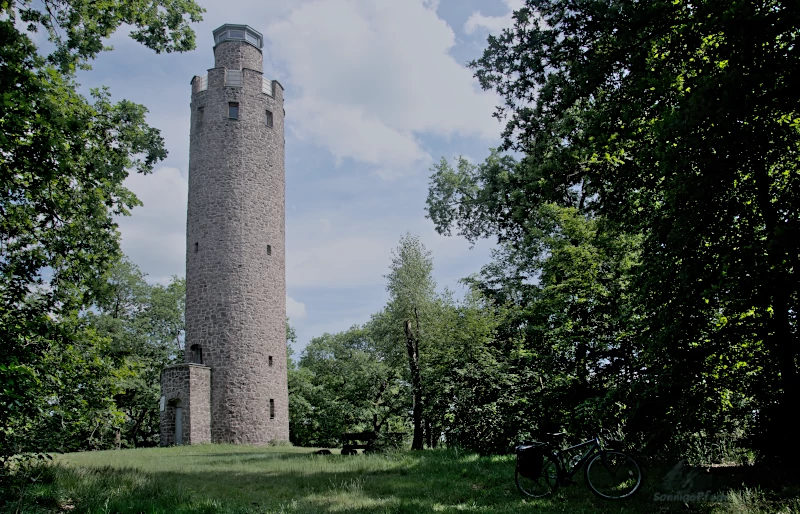
If you are looking for mountains in the immediate vicinity of Leipzig, you won’t find many. The church mountain of Beucha is already perceptible with 20 m above the surrounding countryside. Further east above the Mulde River, the Hohburg Mountains border the „Leipzig Lowland Bay“. And, quasi as a continuation of this mountain range in the direction of the Dahlener Heide (Dahlen Heath), the Schildberg Hill near Schildau, at 217 m above sea level, rises a bit further out of the landscape. With its surrounding forest area, it is an excursion destination not far from Leipzig and a link for hikers between the Hohburg Hills and the Dahlen Heath, which it closes off to the west.
Hiking in the surroundings of Leipzig – over the Schildberg
Mountains? Near Leipzig? Many will probably start to smile when they think of their Tatra – hikes in Slovakia or the last trekking trip to Nepal. In contrast, the surroundings of Leipzig are as flat as a piece of pizza! But it doesn’t always have to be 3000m high mountains…
For a varied excursion at the weekend, a longer hike in the vicinity or a short trip in between, a smaller elevation is probably enough. Like the Schildberg. After all with 217 m! at the hilltop above sea level. And a varied forest all around, meadows, small brooks and old quarries, which let a breath of mountain feeling arise. All this characterizes the Schildberg – forest near Schildau, with the Schildberg hill and its tower a landscape mark on the western edge of the Dahlener Heide.

An old fellow – the Schildberg hill near Schildau
After all, the Schildberg is already several million years old. Up to 270 million, to be exact. Because like the neighboring Hohburg hills, the Schildberg was formed in the new red conglomerate by volcanic eruptions 270 to 240 million years ago. This is also the origin of the rock that forms the core of the Schildberg hill – quartz porphyry. It even withstood the ice ages that began about 2.6 million years ago and shaped the landscape. Well, probably Schildberg was also quite ground down by the ice of the glaciers, which could be an explanation for its flat, elongated shape.
This shape provides some people with one of the interpretations of its name: Schildberg, the mountain with the appearance of a (flat lying) shield. From a distance, one could even gain something from this naming. Because from many distant observation points, whether from the north at the railroad line Leipzig – Cottbus, from the east from the Dahlener Heide or from the west with the Hohburg hills, the Schildberg actually lies like an elongated shield with a shield hump in the middle in the landscape. The top of the Schildberg tower, which towers above the woodland by a few meters, is then the ornamental knob on top.
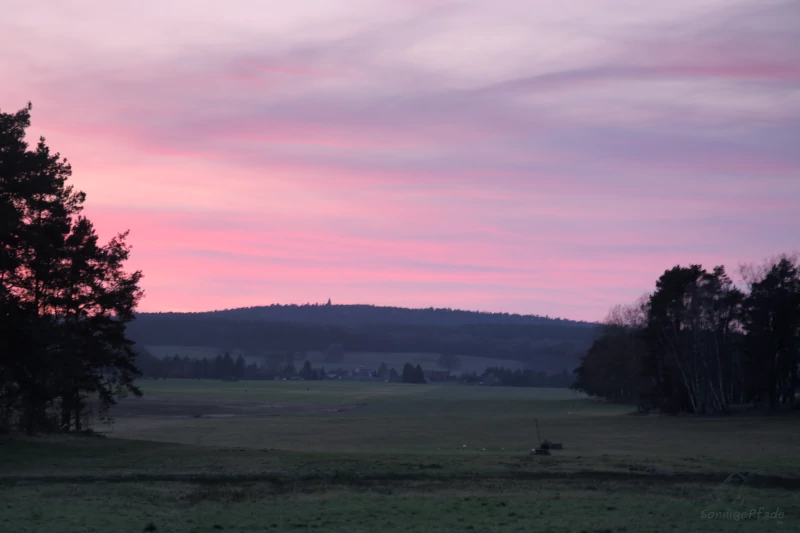
Many cartographers make it easier for themselves in their maps. They name the hill near Schildau without further ado with „Schildauer Berg“ (Schildau’s mount) and ignore the locally usual designation Schildberg. This circumscribes another possibility for the origin of the name – Berg bei Schildau (Hill near Schildau) – the „Schildauer Berg“ (Schildau’s mount) or, more succinctly, „Schildberg“ (Schildmount). Locals would follow this logic loosely, because for the Schildau citizens the Schildberg belongs to the town.
In the Schildberg – Forest
The Schildberg hill is surrounded by larger forest areas. And to the east there is a direct connection to the Dahlener Heide (Dahlen heath), so even more forest! This makes the region interesting, e.g. for excursionists from east german cities Leipzig or Halle (at Saale river) and of course the inhabitants in the surrounding area.
While in GDR times (former socialist East Germany) pine forests were predominant at the Schildberg, which gave large parts of the forest a rather monotonous appearance, the picture is changing slowly but steadily. The conversion of the forest is beginning to bear fruit, so that the proportion of deciduous forest is increasing, especially with oaks and beeches. In addition, the storms Herbart and Friederike hit hard in the winter of 2017/18, so that many of the old pines have broken off or fallen completely. Snow breakage at the top of Schildberg a few years earlier adds to the problem. So the Schildberg forest looks quite plucked in some places right now. Three years of drought and the bark beetles also mean that there are a lot of dead trees in the forest, and some stands are thinning out considerably. But everything has its good side. Great spotted woodpeckers were always numerous in the Schildberg forest, but since the forest has been plagued by beetles and old trees have been left dry, attentive forest walkers are seeing black woodpeckers more and more frequently in the Schildberg forest.
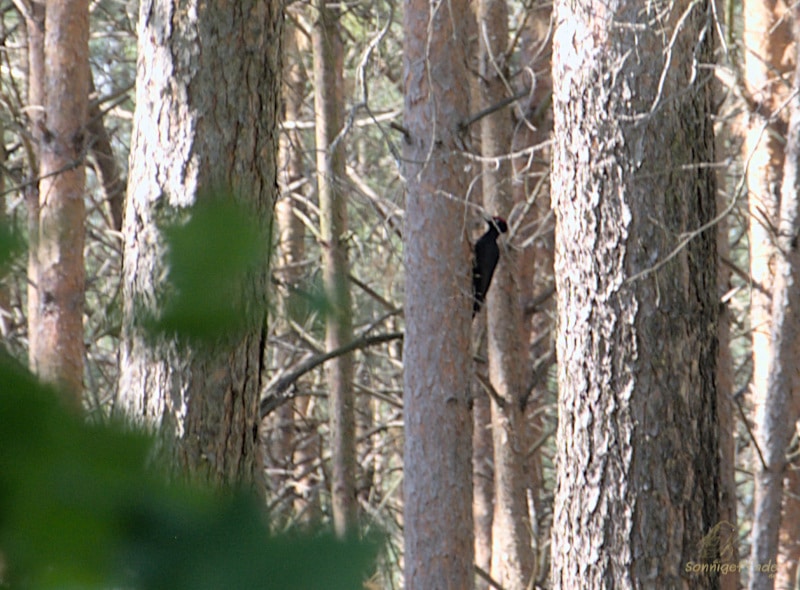
Exciting are also the territories around the two „Hasenteiche“ (hare) ponds, which are already visited by toads for spawning in early spring. Originally, the ponds were probably created centuries ago to provide more water retention for one of the water mills in Schildau. In the 1980s, the ponds were dredged and de-silted by the forestry company in order to have a larger water reservoir and, if necessary, quickly accessible reserves of fire-fighting water in the Schildberg forest.
During the drought years from 2018 to 2020, both hare ponds were more or less dried up. But the year 2021 at least brought sufficient precipitation for the ponds to fill up again and also for the sedge ditch, which flows from the ponds in the direction of Schildau, to carry water again. The valley depression between the ponds and up to the edge of the forest is a small forest of alders and oaks. Behind the Lower Hare Pond there are several „biotope – trees“, old gnarled oaks, partly already dead, which have numerous caves for woodpeckers and bats as well as in the rotting mulch inside habitat for rare protected insects such as the Heldbock and Eremit.
There is another special feature in the Schildberg forest – a free-living colony of honeybees. Beekeepers often think that there is no such thing at all anymore, because Varoa – mites destroy all free living bee colonies without the beekeepers‘ intervention. This one in the cavity of an old oak tree has been around for a few years….
Since some years the Schildberg forest is also wolf territory. The area is too small for a wolf pack – the pack lives rather in the Dahlener Heide and also roams through the Schildberg forest. This is a short walk for wolves, as the animals cover up to 70 km a day.
The Schildberg forest belongs to the Dahlener Heide landscape conservation area (LSG) and is thus protected under nature conservation law. However, the protection status LSG is very low.
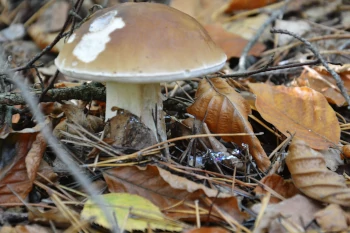
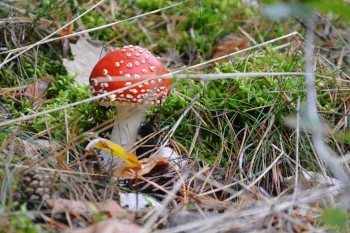
Experience the Schildberg – Hikes and explorations in the Schildberg Forest
From Schildau to the Schildberg – left or right, a question of „dramaturgy“
If you want to work out the Schildberg properly and combine an eventful day with it, you should do a hike to it. It is allowed to drive into the forest by car (until below the Schildberg, the hilltop itself is closed for motor vehicles), but it is not really nice. First of all, the cars always disturb the forest experience and the observation of nature, and secondly, the self-earned climb to the summit is much more likely to be remembered if you had to make a little effort for it. And it’s really not that bad – even with a toddler and a stroller you can walk to the Schildberg. The Schildau elementary school students do it all the time as a hiking day.
We recommend the path along Schildau Friedensstraße (peace street) past the cemetery (with a stop at the ice cream parlor!).
Friedensstraße is lined with lime trees and forks at the end of the village into Thammenhainer Weg (-way) (to the left or south) and Schildauer Triftweg (to the right or north). I would make the choice dependent on the means of transport – by bike I would continue left, on foot right. Because the Thammenhainer Weg, so left, rises slowly but steadily, which is fine by bike, but is boring on foot. So a question of dramaturgy! If you change to the Schildauer Triftweg on foot, you pass a few more houses on the right side. Then the view opens on a wide meadow, which is cut by the Seggengraben (sedge ditch). The path is lined with old trees and mostly covered with soft grass, so it runs well. In the forest, after a few hundred meters, there are two ponds on the right – the Hasenteiche (hare ponds). You can take a break on a bench and enjoy the silence.
When at the end of the Triftweg a wider way crosses, you can walk uphill to the left (recommended with stroller!). But it’s better to go a bit to the right and then turn left onto an old forest path. Because there you reach the foot of the toboggan run on the Schildberg, and that means some scrambling… for all those who want at least a little „mountain hiking“. Yes, this climb is called toboggan run by the locals, because in the past, when there was still snow, you could also toboggan nicely on the Schildberg hill….
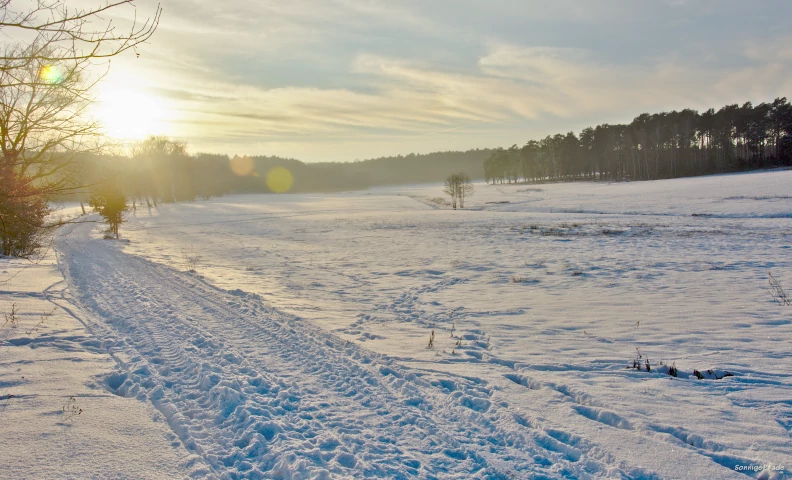
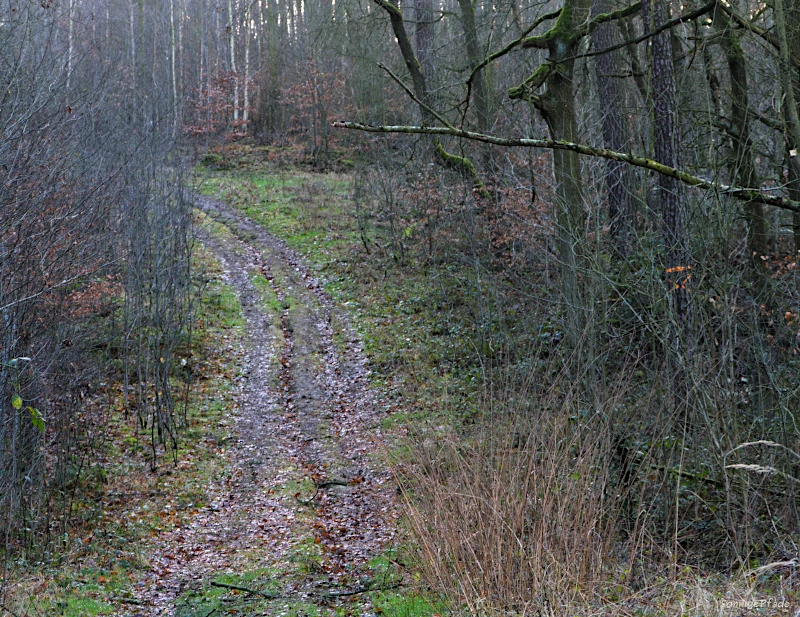
Other ways to the Schildberg
Also from Schildau, but a little further, you can take the Kohlweg (Cabbage way) to the „Bierweg“ (beer way). However, you have to bring the beer yourself, e.g. from the Netto grocery, which you pass as the last house on the outskirts of Schildau. Then you walk a few hundred meters along the street to Kobershain, which is not so nice, but allows an open panoramic view. On the left is the junction to the Kohlweg, which leads you into the Schildberg forest. At the edge of the forest is also a shelter, in case you are surprised by rain or need a break for a picnic.
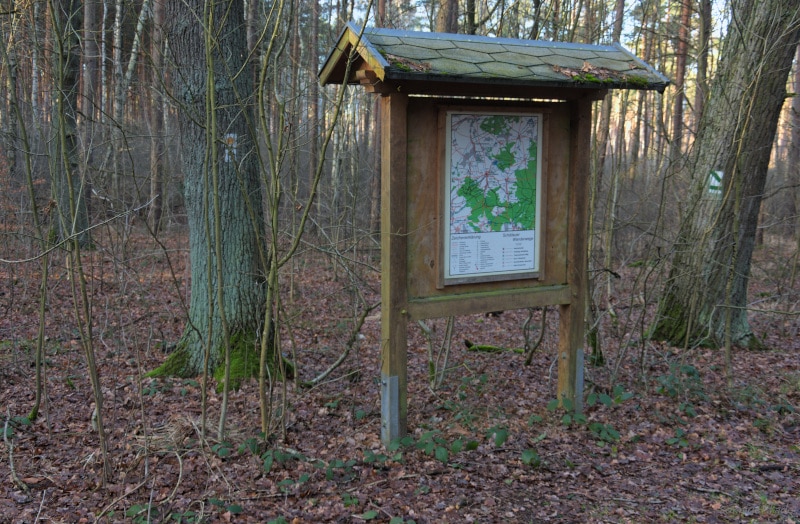
From the southern „tail“ of Schildau, the district of Schilderhain, there is also a Triftweg (drift path) – the Schilderhainer Triftweg. The Schilderhainer Triftweg starts in the S-curves of the road S23 to Wurzen (on the left a single house, on the right it starts…). By the way, the name Triftweg comes from the cattle’s departure to the pastures. You can also use this as a variant for the way back.
If you come from Wurzen by car and don’t want to drive to the town center of Schildau, you can park in the forest in Altenhain at the S23 and start walking. This is the way opposite the junction to the forest nursery Schildau (S-Way). There was once a bus loop, which is suitable for parking. The small hike to Schildberg can be varied a bit by adding some loops in the forest area southwest of the direct (S-) path.
If you stay at the Manor hotel in Kobershain, you can also hike from there to the Schildberg. There you pass the Kobershain wind mill and then continue in a southeasterly direction. The ascent to the Schildberg leads along a small path that branches off to the left from the main path shortly after the beginning of the forest.
Not too much can go wrong in the Schildberg forest. So, no one has gotten lost and lost for days here for centuries. Because all important ways are more or less well signposted and at a few places also again overview maps stand.
The Schildberg – Plateau
On the Schildberg there is a relatively large, quite flat area – so to speak the already mentioned „shield hump“. This is partly tree-covered, but also with some meadow areas. Of the many shelters created by various ABM (Work procurement measure) and other measures, two are still standing, so that you will definitely find a shelter on the Schildberg in case of sudden bad weather. Attempts to establish a snack bar for the summer season on the tower plateau failed years ago. The hikers to the Schildberg are not so numerous that it is worthwhile.
Schildberg Tower
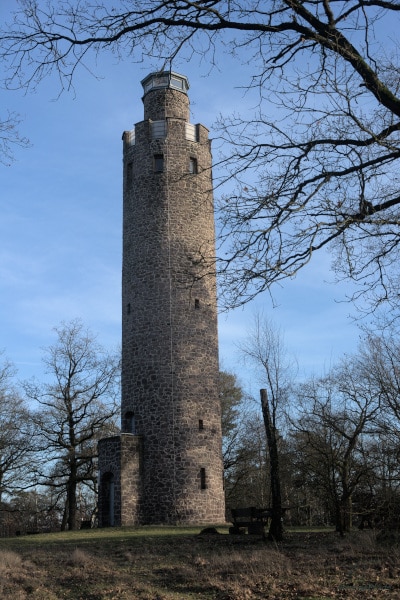
The most important landmark and attraction on the Schildberg is the stone Schildberg tower. This was built in 1936, with stones from quartz porphyry, which were extracted from the quarry directly below the mountain. The tower height is 25m, the diameter is about 5m. Without the Schildberg tower, there is hardly any view from the Schildberg – plateau, especially from spring to autumn, when even the deciduous trees are all wearing dense leaves. Because the mountain top is forested all around.
From the Schildberg tower you have a good panoramic view over Schildau, the Dahlener Heide, over to the Collm near Oschatz, to the Hohburg hills in the southwest. If the weather is good and the view is clear, you can also see the „Wisdom tooth “ and the Battle of the Nations Monument in Leipzig in this direction. That is about 50km distance. To the north, on the horizon, are the forests of the Dübener Heide. There the radio tower near the village Roitzsch is a well recognizable landmark.
The Schildberg tower is usually open during the summer season (approximately from Easter to September) on weekends (Saturday and Sunday) and holidays. If there is a high risk of forest fire, the tower remains closed. Larger groups can, if necessary, inquire at the tourist office of the city of Schildau whether a special opening on a certain date is possible. Entering the Schildberg – tower is at your own risk, in case of thunderstorms you should leave the tower.
The access to the Schildberg tower is first of all on approx. 5m over a stone outside staircase. Then inside the tower there is a wooden spiral staircase over several steps. The last section is a steep staircase up to the observation deck, which leads around a raised stone tower parlor. The tower parlor at the very top is not open to the public.
Until the 90s, it was used as a fire watch out in case of forest fires. That is, when higher forest fire warning levels were in effect for the Dahlen Heath, a forestry employee sat on the tower all day looking for possible smoke development. From below, you can still see a round graduation on the ceiling of the tower room. If smoke rose somewhere, a degree was read off the compass rose. This was reported to a central office. By taking cross bearings with other towers, the location of the fire could be determined precisely.
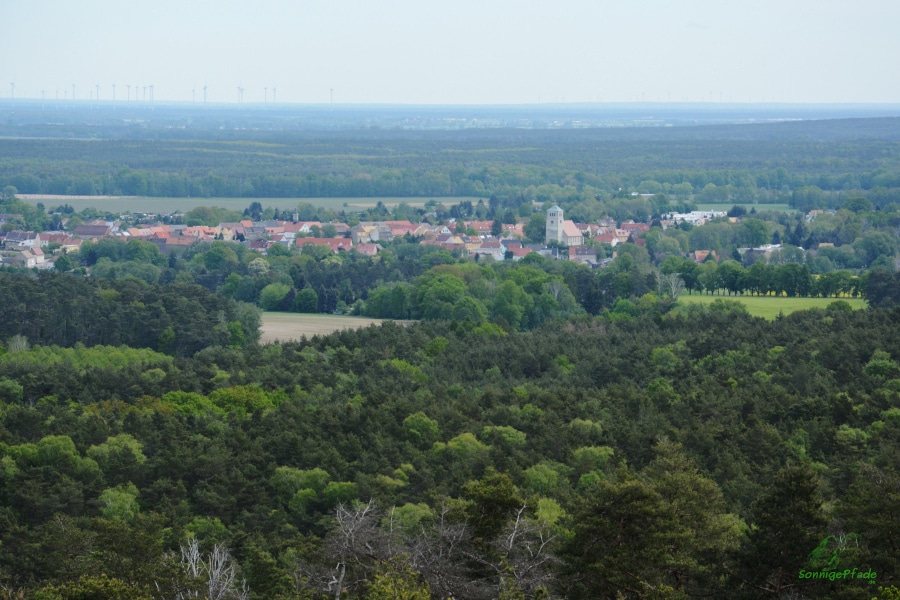
Quarries in the Schildberg – Forest
Napoleon stone and Heßlers gorge
If you leave the Schildberg via the south slope in the direction of „Heßlers Schlucht“ (Heszlers gorge), after about a third of the way there is a branch to the right. There a path goes above the „Gorge“ to the southwest slope, where you will find the Napoleon stone. This is a boulder of quartz porphyry, on one side with a small grotto. If you will, the miniature version of a „Boofe“ grotto like in Saxon switzerland, but for maybe two lying people 😉 . According to legend, Napoleon camped at the Napoleon Stone on his retreat on the eve of the Battle of the Nations near Leipzig 1813.
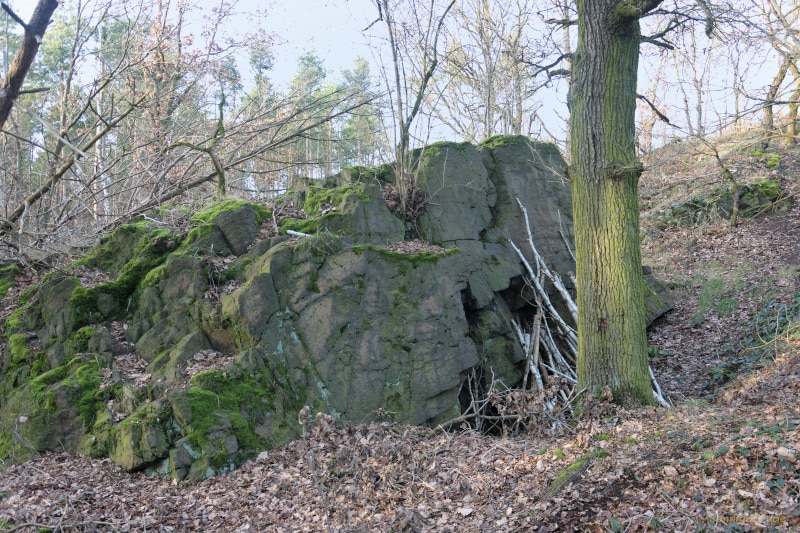
On the southern slope of the Schildberg is, as already mentioned, „Heßlers Schlucht“ (gorge). This is one of the former quarries in the Schildberg forest. The „Heßlers Schlucht“ is also called „dry quarry“ by the locals, because it is more or less level with the surrounding area. Stone was thus quarried from the Schildberg at ground level without having to haul material out of a pit.
As a result, hardly any water could accumulate in the quarry. Today the quarry is a small natural refuge. The quarry wall faces south and collects a lot of heat in summer, although in the meantime mainly black locust trees have grown up and shade the wall. The formerly large quarry meadow has been partly dug up, so that now about 2/3 of the area are rather shallow ponds and thus a refuge for amphibians. If there are no quad drivers or similar ignorant contemporaries driving illegally into the quarry, this is a very quiet place. Right next to it, hidden and hardly accessible, is the smaller Devil’s Gorge.
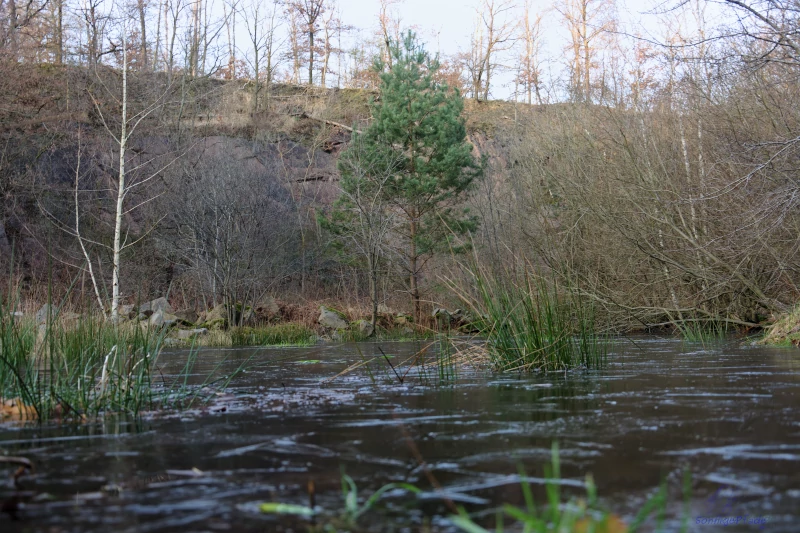
Boundary stones – border between Kingdom of Saxony and Prussia
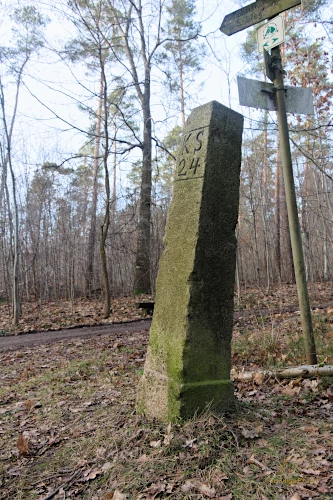
On the southern slope of the Schildberg runs the so-called S-Way, which, coming from Kobershain, continues in the direction of Ochsensaal. This S-Way also has historical significance – again in connection with Napoleon. After the Congress of Vienna in 1815, which regulated the reorganization of Europe after the defeat of Napoleon and his allies in the Battle of Leipzig, the Kingdom of Saxony had to cede parts of its territory to Prussia. The new border line ran along the S-Way and across the Dahlener Heide. In the woods south of Schildau, in several places you can still find the old boundary stones with the engraving KP and KS for Kingdom of Prussia and Kingdom of Saxony, marking the border established in the Congress of Vienna. This border was not revised until 1990, when the states were reestablished in the final phase of the GDR. Citizen polls showed by a majority that the northern Saxon territories should be reattached to Saxony.
The „Wet“ – Witte’s quarry
If you now follow the S- Way in an easterly direction (Ochsensaal), you will find another quarry after just under a kilometer – Witte’s Quarry. This quarry, also called „Wassersteinbruch“ (water quarry) or „abgesoffener Steinbruch“ (flooded quarry), is a pit that was accessed via a narrow access ramp. Since the quarry pit is below the surrounding level, it filled up with precipitation water after the quarrying operations were abandoned. In the eighties, the Mining Office had a series of blasting operations carried out in this quarry. The aim was not to break up the quarry, but to use the sound waves generated to examine the underlying rock layers for „open“ rock formations. In other words, whether there are any other mineral resources worth mining in the subsoil. For the onlookers at the barriers, the hundreds of meters high water fountain that shot up into the air after the ignition and was driven over the forest by the wind was particularly spectacular.
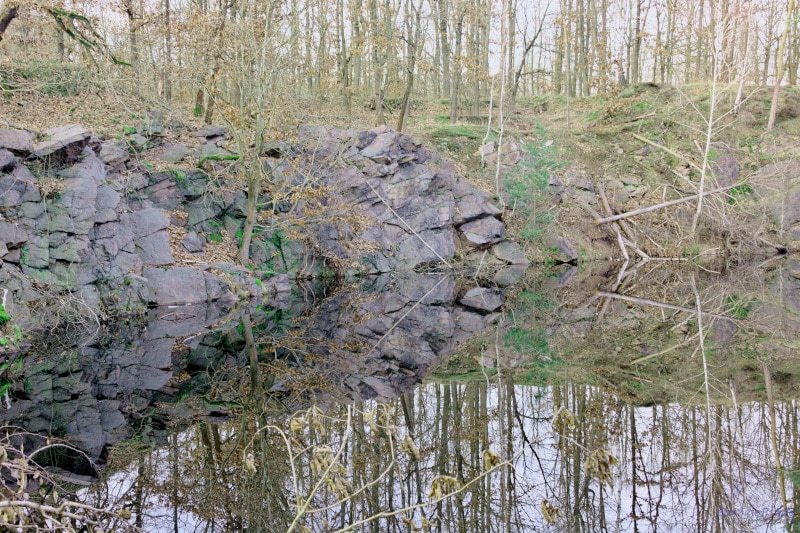
Witte’s quarry is also a small nature reserve as an aquatic biotope. I myself have been able to observe grass snakes at the quarry, which like to sun themselves on stone ledges and swim and dive in the quarry.
From Witte’s quarry the hiking tour can be completed. Via a connection to the north you reach a trail spider. There the Schilderhainer Triftweg (all the way to the right), crosses the Thammenhainer Way (on which it goes right back to Schildau, left in the direction of Thammenhain village) or straight ahead to the driveway on the Schildberg (recommended for cyclists) or after a descent further down to the Schildauer Triftweg with the Hare ponds …..
Hikes over the Schildberg – from the Hohburg Hills to the Dahlen Heath
If such a small walk of maybe 3 – 4 hours from Schildau to the Schildberg hill and back is too little for you, you can also plan a big hike over several days in the region. The Schildberg is then only a stopover, a stage destination with the possibility to look far ahead over the next stage. If you connect several of the landscapes around the Schildberg, the region becomes an interesting and quickly accessible hiking area for people from Leipzig, for example. If you choose the „right“ hiking trails, you even stay away from busy roads to a large extent and can enjoy relaxed hiking tours.
My hiking recommendation would be to hike over the Hohburg hills and the Schildberg into the Dahlener Heide. Since there are no spectacular climbs, such a hike is easy to manage even for less experienced hikers. The length of the stages can be easily adapted to your own physical condition, since villages can be reached quickly everywhere.
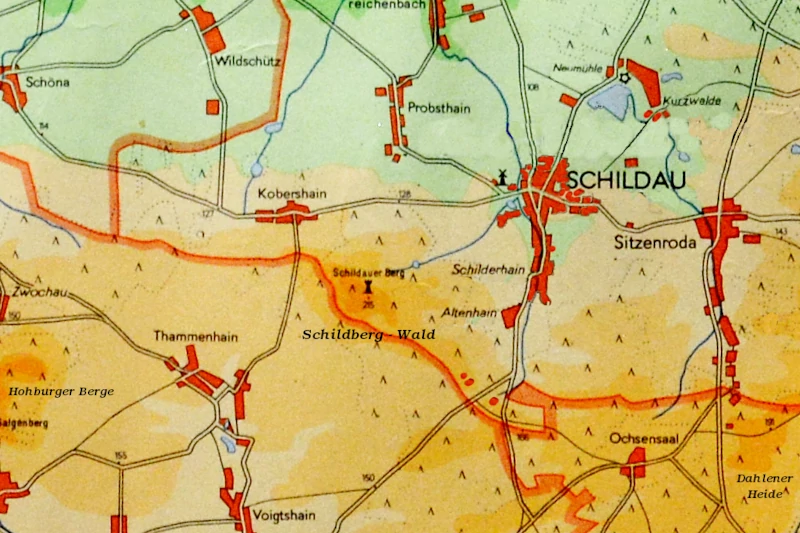
From Wurzen over the Hohburg hills to the Schildberg
You can start the hike to the Hohburg hills already at the S suburban train station Wurzen. From there it goes hiking first through the small nature reserve at the Spitzberg north of Wurzen, then to the village Lüptitz. Under the old railroad line Wurzen – Eilenburg a bicycle / hiking trail leads to the Kleiner Berg (Small Hill) near Hohburg. Except in the villages, the hike leads exclusively along car-free paths. An alternative would be to take the local bus from Wurzen to Hohburg.
From the Hohburg hills you can pass the village Zwochau and reach a kind of ridge trail as a west – east axis, on which you pass Kobershain village to the south and reach the Schildberg hill. Kobershain with its manor hotel can also be a good place to spend the night at this stage. The hike from Hohburg to Schildberg covers 11.6km. Here the link to openrouteservice with download – possibility for .gpx-tracks for this hiking – route.
Hiking from Schildau to Dahlener Heide
From Schildberg there are several possibilities to the east or southeast. If you hike to Schildau, you can walk from there into the middle heath to Taura and further through the northern Dahlener Heide to Belgern on the Elbe (connetion to the Elbe cycle path). With the Elbe ferry in Belgern it would even be possible to cross the Elbe river and then continue in the East Elbe regions, perhaps to Bad Liebenwerda in Brandenburg.
From Schildau, a hiking and biking trail leads to Sitzenroda village as well as hiking trails in a southeasterly direction to Ochsensaal or in the middle of the Dahlener Heide at the Jägereiche (hunters oak). You can more or less cross the Dahlener Heide to Reudnitz, to Strehla at the Elbe (Elbe cycle way) or to Dahlen, from where regional trains go to Leipzig or Dresden.
If you don’t want to hike to Schildau, you can also follow the S-Way from Witte’s quarry, which takes you past a Bronze Age burial mound to Ochsensaal village. From Ochsensaal you can also hike on to Schmannewitz and there into the Dahlener Heide. Or you can go straight on behind the tumuli to the A – path, which makes a hike in the middle of the Dahlener Heide past the Sieben – Quellen – Tal (seven spring valley) near Sitzenroda to the Jägereiche (hunters oak) possible. (Schildberg – Jägereiche about 12km, here the link to the hiking route with gpx – track download possibility) From the Jägereiche further hikes are possible virtually in all directions of the Dahlener Heide.
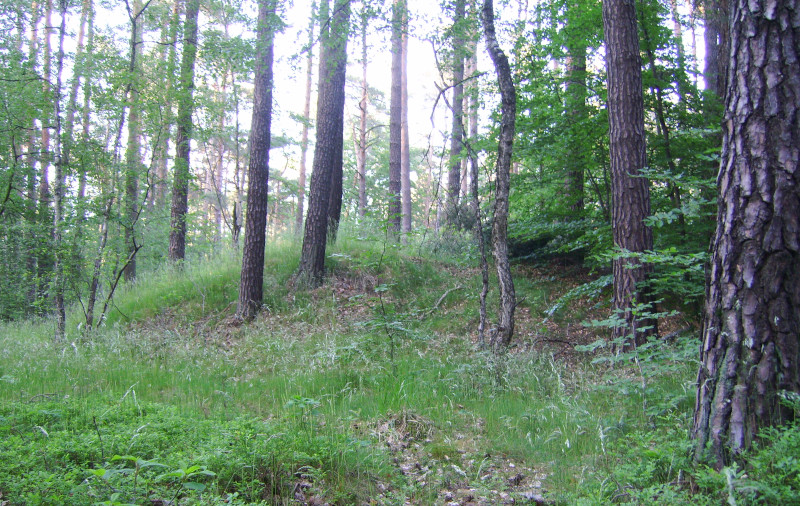
With children at Schildberg
A hike in the Schildberg forest is also an exciting and easily manageable affair, especially for children. Especially with the right „dramaturgy“ 😉 The change from meadow to forest, from deciduous forest to coniferous forest, the calls of birds, the hammering of woodpeckers, the rustling of the wind in the pine crowns, the hare ponds with their little stream, the challenges of the climb to the mountain plateau and the Schildberg tower as a view, in autumn numerous mushrooms…. all this offers plenty of variety, so that children can be well motivated to go on a journey of discovery in the Schildberg forest. This is worthwhile even several times, if one varies the routes, not all attractions (e.g. quarries or Napoleon stone) at once „checked off“ and so between „rediscovery“ of known and surprising news the children bit by bit in the „expedition area immerse“ let.
In Schildau, the Schildbürger (literally Schilda citizens, comparable with the wise men of Gotham in UK) are present with their foolish pranks and teach children a little episode from German and European literary history. A Schildbürger prank book for children* in your luggage, e.g. the colorfully illustrated German edition by Erich Kästner, can serve as evening bedtime reading or for the break in between for entertainment.
And those who want to spend a weekend or several vacation days in Schildau and at Schildberg, will find a few more tips below.

Horseback riding at Schildberg forest
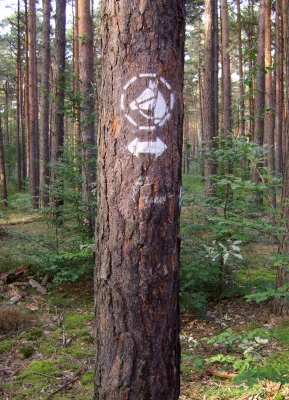
On the Schildberg and in the Schildberg forest there are several bridle paths, which are connected with the bridle path system of the Dahlener Heide. So you can also explore the Schildberg on horseback. Riding farms are e.g. in Sitzenroda (Reiterhof Scharf, offer also Kremserfahrten (horse-drawn carriage rides); Zum Quellental 42 Sitzenroda, unfortunately no web-site, Tel. 034221 5 03 23) and Taura (Reiterhof Heideland). Schildau is also a center of horse driving with a horse – driving sports facility, the Horse driving carriage arena.
A whole weekend in Schildau?
Yes, even one or two days longer you will find more attractions on site. Just the hike to the Schildberg can fill a whole day. Especially if you enjoy the quietness at some places like the Hare ponds or at the Napoleon stone and stay longer.
Another hike would be possible south of Schildau, even if there are not quite as many great attractions along the way. But with the Bronze Age burial mounds, a visit to Ochsensaal, maybe even a swim in the Dammühlenteich (pond near Ochsensaal) and another „border crossing“ with border stone between the kingdoms of Saxony and Prussia, such a hiking day can be well designed.

In addition, you will find some sights in Schildau itself. These are mainly the Schildbürger with their pranks. The Schildbürger – museum is open (mostly) also on weekends. The Schildbürger – fountain with numerous „hidden“ Schildbürger pranks is accessible day and night anyway. A small „Schildbürger – Circle way“ can teach children about the pranks of the Schildbürger at different places in the city. (Overview Schildbürger – Circleway – .pdf)
Schildau is less known as the birthplace of the Prussian General Neidhardt von Gneisenau – a monument on the market place reveals with bronze reliefs four stations in the life of the army reformer, including his childrens days as a goose boy in Schildau. There is also a small exhibition on Gneisenau in the Schildbürger museum.
The oldest mulberry tree (Morus alba) in the German-speaking area has been growing for over 500 years at the town church of St. Mary, which is well worth seeing. It was planted to provide fodder for silkworms. And in the parish, a project group is working on the „Garden Earth Realm„, where a publicly accessible project garden is being created from the historic and listed parish garden. Visitors can already „smell“ various fragrant plants from all over the world via a meandering path or look into the small wilderness zone from a viewing platform.
Those who simply want to bathe and relax after a long hike can do so at the Schildau lakeside resort Seebad. There, both a natural lake and an adventure pool with slide offer bathing fun for young and old. A camping site belongs to the lake bath. So, already in Schildau there is more than enough to experience for two or three days…
Gastronomy in Schildau
If you hike a lot, you should not go hungry. Below the Kirchberg (Church hill) on Wurzener Straße (Wurzen street) you can fortify yourself with pizza and possibly some Indian dishes in the restaurant „La Cabane“ (formerly Toscanella or Dantes). Menu La Cabane Pizza is also available to take away, but in the quiet dining rooms with fireplace in winter it is much more pleasant to dine. In summer, an outdoor seating area in the courtyard offers hospitality in the fresh air.
Conveniently located on the (back) way is the „Eiscafé zum Schildberg“ (Ice cream parlour ‚To the Schildberg hill‚ right there – in the Friedensstraße, which leads to the two above mentioned paths towards Schildberg. There are homemade ice cream sundaes, but also a small snack at lunchtime.
If you want to go to the seaside resort anyway, you can visit the snack bar „Hai five“ during the bathing season. There you will find everything that belongs to the culinary „beach life“.
Accommodation in the surroundings of Schildberg
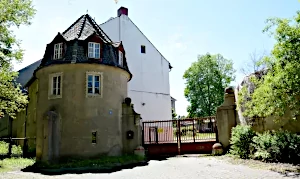
The closest to the Schildberg is the above mentioned Schloßhotel (Manor house Hotel) in Kobershain*. In the former manor you will find a comfortable night’s lodging. An apartment for two and a family suite await their guests. Even vacations with a dog are possible here. For shopping the short drive to Schildau is necessary.
To the seaside resort in Schildau also belongs a camping site for tents and caravans* with own camper – pitches. In addition, the town of Schildau offers group accommodation at the lakeside resort, which can be booked through the tourist office.
Really in the middle of the Dahlener Heide in Lausa is the Pension Lausa*. The bungalow offers as a vacation home space in each 2 single beds in two bedrooms. In the simple kitchen there is a hotplate, microwave and kettle for food preparation. Vacations with dog or other pet are possible here. Shopping is possible in Schildau or Belgern.
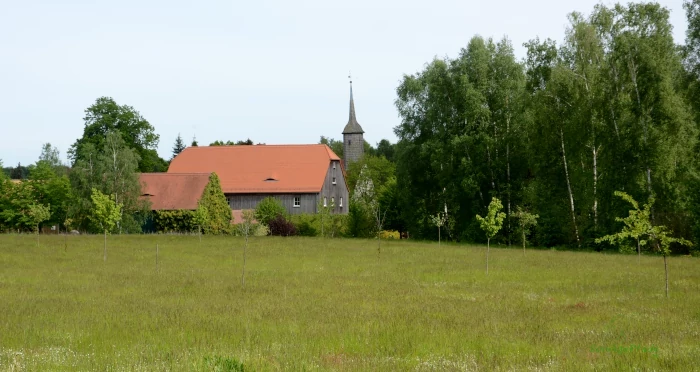
In Schmannewitz you can book your vacation apartment with the Deutschmann family*. This is best suited for four people, but it can also be up to 6 (sofa bed in the living room). Kitchen and bathroom of the apartment are well equipped, in the garden you can grill and play table tennis. From Schmannewitz all destinations in the Dahlener Heide are easy to reach by bike. The forest bath of Schmannewitz attracts!
Hiking to the Schildberg? Where can I park?
If you make your way to the Schildberg forest by car, there are several options for parking. The best is in Schildau on the market place or at the Volkshaus. You can also use the parking lot at the Netto grocery market, which is already on the „right“ edge of town (west side) and from where you can start hiking right away – either via Kobershain street, Kohlweg and Bierweg or via „UnterdenLinden“ and Friedensstraße.
If you come from Wurzen, you can also park in the forest at the intersection with the S-Way. There used to be a bus stop there, so the junction has been developed into a bus sloop. However, buses no longer stop, so that the space is now available for parking for about 5 cars.
How can I get there by public transport?
A difficult topic… Although Schildau belongs to the area of the mdv traffic association, the regional bus service still serves mainly the school traffic. And it is based on school times, not on the timetables of the mdv suburban trains! On weekends there are no buses at all, despite good tourist offers in Schildau. From Monday to Friday it is possible to take the S suburban train from Leipzig to Mockrehna or Torgau and from there take a bus to Schildau – but be sure to plan the whole connection in advance! On weekends, a so-called +plus bus does not go via Schildau, but through Sitzenroda, 3km away. The way there is quite good hikeable. With the +plus bus there is now and then also a possibility to get into one of the S- trains in Torgau (or in Oschatz into a regional train Leipzig – Dresden). Note my mocking or rather sarcastic undertone …
If you are a hiker anyway, you can hike from the Wurzen train station as described above via the Hohburg hills to the Schildberg or from/to the Schildberg via Ochsensaal, Schmannewitz to the Dahlen train station (also regional train Leipzig – Dresden). Otherwise, the combination S suburban train + bicycle is recommended in the region, especially since the bicycle transport in the S- and regional trains of the mdv transport association is free of charge.
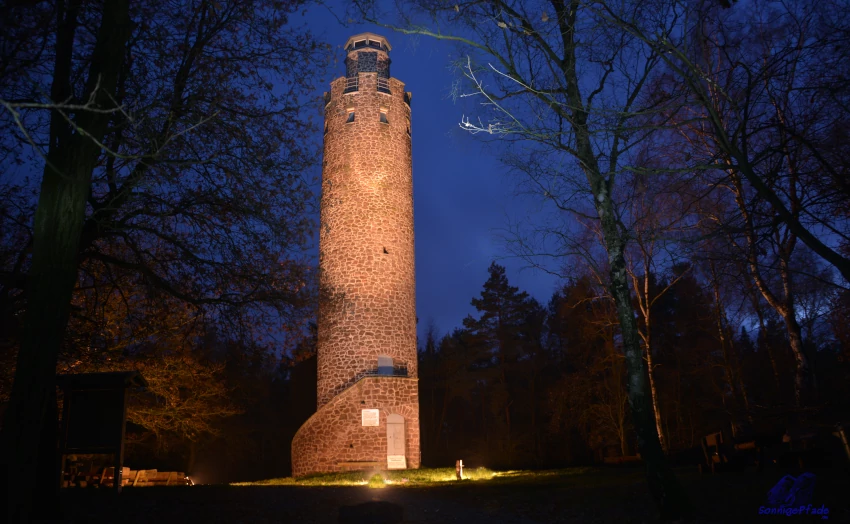
Hiking map Dahlener Heide
For your planning of excursions and hikes in the region at the Schildberg you can best use the cycling and hiking map Dahlener Heide, Wermsdorfer Wald and surroundings* from the Barthel publishing house. This is created in the scale 1:50,000 and thus sufficiently detailed to find your way around.
Already on the road in your mind? Invite your friends and then off to the Schildberg!
For your trip from Leipzig or wherever to hike the Schildberg, you can inform your friends by sharing the link to the post on your social media channels. Thank you!
Note on * advertising links
This post contains * marked links to agencies, online – stores, etc.. If you click on such a link and order something, the Sonnige Pfade blog receives a small commission to cover the operating costs. For you nothing will be more expensive, because the providers already include the commission in the pricing.
